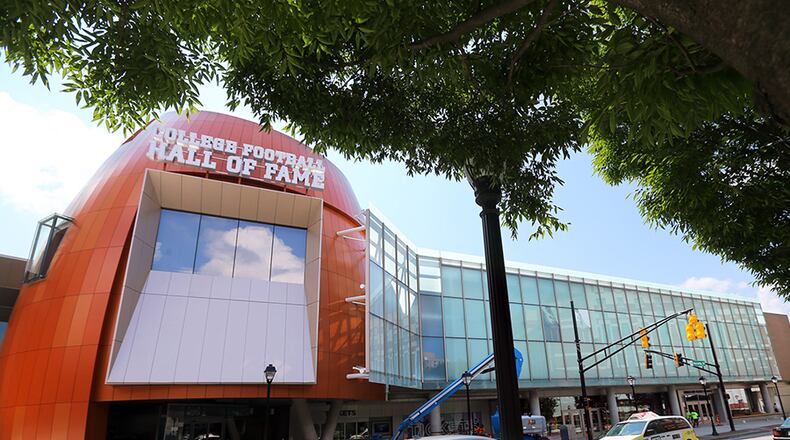The College Football Hall of Fame left something behind when it relocated from South Bend, Ind., to Atlanta: about 1,100 plaques honoring the inductees.
Bronze plaques or busts long have been a staple of sports halls of fame, but they don’t have a place in college football’s new 94,256-square-foot shrine near Centennial Olympic Park.
The decision to exclude the plaques was consistent with the goal of an interactive, high-tech attraction — but one not made lightly.
“A lot of thought went into it,” said John Stephenson, the attraction’s chief executive. “We wanted to make sure that we hit the mark on being a new way to engage with the Hall of Famers, but we also wanted to make sure that when the Hall of Famers come here they feel like they are being honored sufficiently and permanently.”
In the part of the building where visitors might expect to find plaques or busts — a circular room on the top floor with rich wood walls and a reverential feel — they instead will find 10 swiveling, five-foot-tall, flat-screen digital displays that can access far more content on each Hall of Famer than would ever fit on a plaque. In addition, the name, position and school of each inductee is etched in lighted glass panels along the sides of the room, providing a permanent presence to complement the searchable displays.
The departure from plaques and busts underscores the philosophy that drove the business model of Atlanta’s new attraction: To be sustainable and self-supporting, it would have to be more than a museum. It would have to be an interactive experience, too.
The strategy is intended to buck a trend among sports halls of fame around the country, many of which have suffered attendance declines amid complaints that they aren’t interactive enough.
Just about everyone involved in the Atlanta project has uttered these words at one time or another: “This is not your grandfather’s hall of fame.”
Atlanta Hall Management, the not-for-profit organization licensed by the National Football Foundation in 2009 to build and operate the College Football Hall of Fame here, made its strategy clear to the designers and architects from the start. The message didn’t change when Stephenson replaced Gary Stokan as the project’s CEO in December 2011.
“They wanted this to … have a wider audience appeal, not just be for someone who says, ‘I’m a college football advocate and going to the church of college football,’” said Patrick Gallagher, president of Gallagher & Associates, the exhibit designers.
“You’re going to see the history of the sport intermingled throughout, but … it’s really more about exploration and enjoyment. This is where we vary a great deal (from other sports museums). I think we have to. I think it’s a more dynamic experience to go to a college game.”
The attraction’s official name — College Football Hall of Fame and Chick-fil-A Fan Experience — incorporates its full scope as well as its lead sponsor.
“The Hall is obviously a celebration of the greatest coaches and players to play the game, but it also is a celebration of the game-day experience,” said Stephen Platenberg, a principal at Cortina Productions, the project’s audio-visual media designer and producer.
The part dedicated exclusively to the inductees is just one room of the three-story building, albeit the grandest room. The rest of the place covers all aspects of college football through historical artifacts and modern multimedia devices: the games, stadiums, fans, players, plays, coaches, cheerleaders, bands, mascots, tailgaters, rivalries. In sum, the experience.
“In context of just square footage, 15 to 20 percent is the actual Hall of Fame itself, where we immortalize and capture all the history of the inductees,” said Steve Robinson, Chick-fil-A’s executive vice president of marketing and Atlanta Hall Management’s board chairman.
“The reason we have been able to pull it off in 15 to 20 percent of the space is because it is probably one of the most innovative uses of technology I’ve ever seen.”
The technology will allow the content to be frequently and easily updated, Robinson and others said.
“The idea is to bring people back and back and back,” National Football Foundation president and CEO Steve Hatchell said. “I was going to museums by the age of 8. Once I’ve seen it, I’ve seen it. The whole idea here is you refresh it all the time.”
The technology also will enable visitors to personalize their experience via RFID — Radio Frequency Identification — chips in their tickets, which are worn like credentials. After visitors register in the lobby and designate their favorite team, various interactive displays throughout the building will recognize them as they approach and automatically cull content on that team.
Hall officials expect 500,000 visitors per year, which would be far more than the Baseball Hall of Fame (less than 300,000 in recent years in Cooperstown, N.Y.) or the Pro Football Hall of Fame (about 200,000 in Canton, Ohio), yet far less than neighboring attractions Georgia Aquarium and World of Coca-Cola.
In its final years in South Bend, the College Football Hall of Fame drew about 60,000 annually, prompting the move to Atlanta — minus the plaques.
“The National Football Foundation was very patient and cooperative in letting us explore the next generation of what we could do,” Robinson said.
Ten years ago, the Chicago Tribune described the plaques in the South Bend facility: “(They) are arrayed in gently rising tiers and bring to mind tombstones on a hillside.” Before finalizing the design that excludes the plaques, Atlanta Hall Management sought the reaction of many Hall of Famers, Stephenson said.
“We had the renderings of the design and asked them, ‘How would you feel about this? Does it feel like it’s sufficiently substantial and has the gravitas you would want to bring your family in and show them you are a Hall of Famer?’”
Their reaction was positive, Stephenson said, especially to the “deep dive on their content,” including video, available on interactive displays called augmented reality viewers.
And where are all of South Bend’s prized plaques as the Hall of Fame opens in Atlanta? They’re in storage in Irving, Texas, where the National Football Foundation offices are located.
About the Author
Keep Reading
The Latest
Featured



